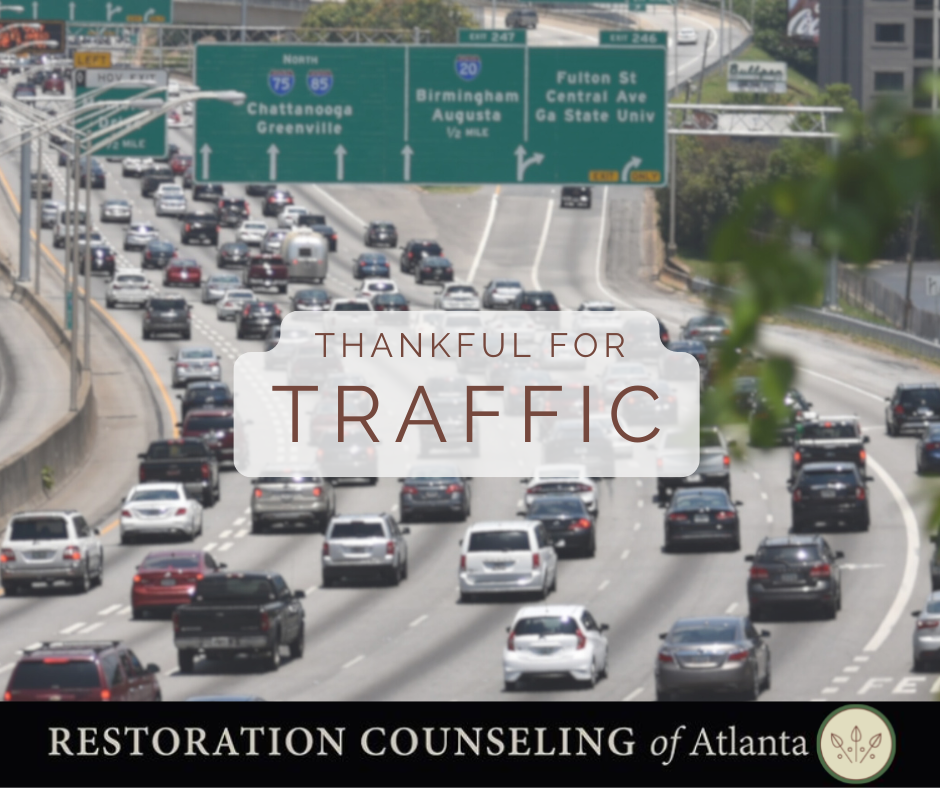Atlanta has many lovely attributes, from the sports teams to the trees, but unfortunately, it is notorious for its massive traffic problem. Recently, as I was sitting in hour three of traffic (thankfully, not consecutive hours), I was reminded of how powerless I am to change things in my life. That day, the slowdown hit me with a wave of intense frustration as I strategized how to make up for the lost/wasted time caused by the endless line of cars ahead of me. After a few minutes of deep breathing, I recognized I could not do much more to change my circumstances. I started to think about traffic as an opportunity to remember my need to accept the things I cannot control—namely, unwanted/unplanned-for intense emotions.
Acceptance
Webster’s online dictionary defines “accept” as the act of agreeing to receive, whether willingly or reluctantly*. In this context, acceptance means acknowledging unwanted thoughts and emotions without judging, dismissing, or resisting the fact that they exist. Some days, it’s acknowledging the intense nervous feeling. Other days, it’s acknowledging the unwanted feeling of jealousy/envy. That day, I could not outrun the powerlessness I felt in traffic. Below, I will outline a way to practice accepting the frustration, powerlessness, or (insert your traffic-induced emotion) that you experience, as a way to grow in tolerating a distressing feeling.
A. C. C. E. P. T. S.
Dialectical Behavioral Therapy (DBT) is an evidence-based talk therapy focused on teaching individuals how to be more aware of emotions, regulate emotions, tolerate stress, and improve interpersonal relationships. A. C. C. E. P. T. S. is a DBT tool used to help people manage a distressing feeling without doing something risky or harmful. This tool is not meant to take the emotion away but rather to help you tolerate the intensity of the emotion in that moment, until it passes. I’ve outlined this tool in the context of driving in traffic.
All of these ideas can only take place if you are abiding by traffic laws—keeping your eyes on the road, hands on the wheel, and foot on the brake/gas.
A—Activities—Do something you enjoy in the car. Listen to calming music. Pray. Call a friend or family member. Listen to a podcast. Practice for your next karaoke night. Notice the nature around you, if you’re near nature.
C—Comparison—Compare your situation to a time when traffic or being stopped from completing a task was worse. Think about a way this is not as bad as it could be or has ever been. Compare this situation to a time when you succeeded in tolerating stress.
C—Contributing—Take your focus off the distress you feel and think about how to be kind and helpful to someone else. How can you contribute to someone else in this moment? Smile at the car next to you. Pray for friends and family members. Think about how to celebrate a loved one in the future.
E—Emotions—Do something that will compete with the strong emotion you’re feeling: Feeling sad, listen to a happy song. Feeling angry, listen to a thought-provoking podcast. Feeling anxious, practice deep breathing: Breathe in for five, hold for five, and breathe out for ten. Continue in that loop five times. Feeling tense: Make different faces (raise/lower your eyebrows; rotate your jaw; scrunch/loosen your face). Use a muscle relaxation tactic like gripping the wheel as tightly as you can and then releasing, noticing the tension in your hands and arms release.
P—Pushing Away—Avoid the intensity of this feeling by temporarily pushing away the thoughts or emotions. Imagine putting these feelings/emotions in a box to sort through at a later time that day. Look at the clock and tell yourself you will engage with these thoughts/emotions in five hours from that time.
T—Thinking—Redirect your thoughts to something neutral. Notice all of the license plates and try to find the funniest one. Count the number of cars with your favorite color. Count the number of cars from different states.
S—Sensation—Engage in a comforting or soothing sensation. Grab a drink of cold water. Blast the A/C to hit your body with a temperature change. Eat a mint or something crunchy. Roll down the window and notice the smells (hopefully they are nice).
This tool can be generalized, but it is not meant to accept or excuse harmful or abusive behaviors. This tool is for the purpose of coping with an intense, painful emotion without turning to a harmful thought or action.
If you are intrigued by anything in this article or would like to understand more about acceptance and powerlessness, please reach out here.
*https://www.merriam-webster.com/thesaurus/accept

Written by Samantha Mathews, MA, AMFT, APC, NCC, CMHC
Woodstock location
samantha@restorationcounselingatl.com
Samantha works with individuals of all ages. She wants to help create space and language for what you may be going through in life. Samantha sees individuals dealing with ADHD, anxiety, depression, gender issues, grief, postpartum depression, and trauma. She also does premarital and marital counseling.

